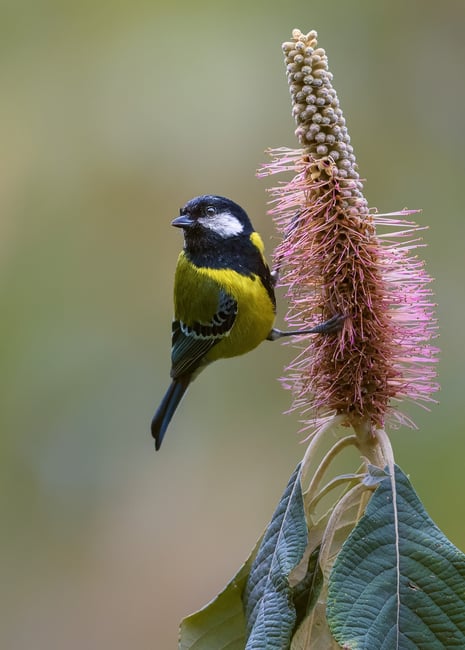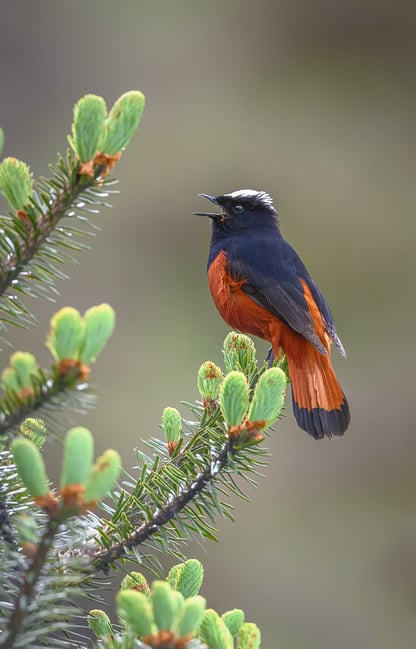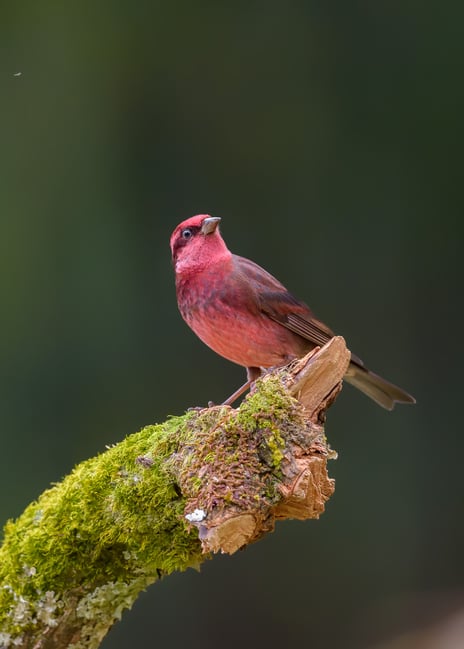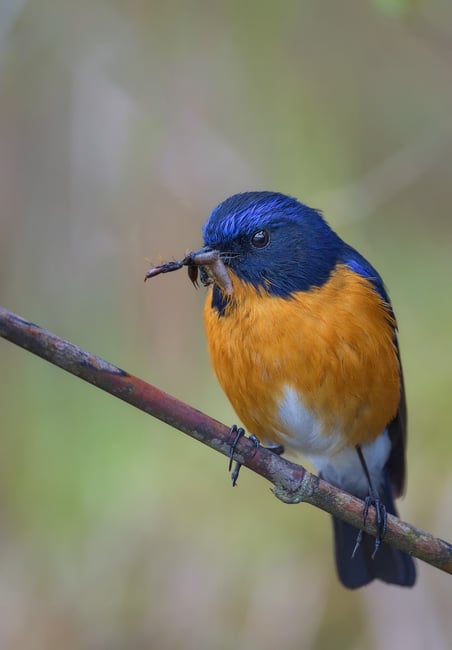Sikkim is the second smallest state in India, lying on the lap of the mighty Himalayas, towards the north-eastern part of the country. Since the proximity of Sikkim is relatively close to my workplace, I have had a couple of chances to visit a few enchanting and secluded hamlets of Sikkim in the last year. I have covered roughly two wildlife sanctuaries.

NIKON D810 + 500mm f/5.6 @ 500mm, ISO 1600, 1/1000, f/5.6
I visited Pangolakha, which is in the eastern part of the state of Sikkim, in the months of May and June 2019. I also visited the lower part of the Maenam Wildlife Sanctuary, which is in the southern part of the state, in the months of January and February 2020.

NIKON D810 + 500mm f/5.6 @ 500mm, ISO 800, 1/250, f/5.6
These little picturesque villages are far away from the hustle and bustle of the city and are surrounded by refreshing green forests, snow-peaked mountains of the mighty Kangchenjunga range, waterfalls here and there, and plenty of flora and fauna.

NIKON D810 + 500mm f/5.6 @ 500mm, ISO 1000, 1/1600, f/5.6
In this article, I will share my experience of capturing a few of my favorite pictures in these tranquil, mystical, and romantic hamlets.

NIKON D810 + 500mm f/5.6 @ 500mm, ISO 2000, 1/800, f/5.6

NIKON D810 + 500mm f/5.6 @ 500mm, ISO 500, 1/80, f/5.6
East Sikkim
I went on a family trip with kids to the eastern part of Sikkim, covering places like Phadamchen, Dzuluk, and Lungthu, at an altitude that ranges from 8,000 to 12,000 feet above sea level, covering the Pangolakha Wildlife Sanctuary.

NIKON D810 + 500mm f/5.6 @ 500mm, ISO 1600, 1/1000, f/5.6
The trip was a mixed bag due to rain and landslides. Even after all the commotion, I have managed to capture some images of several varieties of Himalayan Birds in this region. These areas are the land of Rhododendrons, and the nectar attracts several bird species like Sunbirds, Yunhinas, Fulvettas, etc.

NIKON D810 + 500mm f/5.6 @ 500mm, ISO 1600, 1/1000, f/7.1
The Fire-tailed Sunbird was the showstopper. These avian beauties were in their full breeding plumage and had the longest tail and were treats for the eyes. Fire-tail Myzornis are cute little birds that are always busy collecting insects. Black-face Laughingthrushes, Dark-breasted Rosefinches, Golden Bush Robins, White-capped Redstarts, and Grey-sided Bush Warblers were all found in plenty.

NIKON D810 + 500mm f/5.6 @ 500mm, ISO 1600, 1/200, f/7.1
But the trip was incomplete until we saw a glimpse of a majestic Himalayan Monal. In relatively lower altitude, we found Rufous-breasted Bush Robins, Parrotbills, Minlas, White-throated Laughingthrushes, Woodpeckers, and Turtle Doves.

NIKON D810 + 500mm f/5.6 @ 500mm, ISO 400, 1/500, f/5.6
South Sikkim
The trip into southern Sikkim was a photography tour with my friends. This time we visited a place known as Borong. Borong is a mystical, silent, and dreamy little hamlet in south Sikkim. We stayed in a resort that was situated within the lower part of Maenam Wildlife Sanctuary.

NIKON D810 + 500mm f/5.6 @ 500mm, ISO 2500, 1/3200, f/5.6
Unlike Lungthu, here we don’t have to trek or hike a lot. Within the premises of the resort, there are plenty of naturally growing flower plants like Cestrum elegans, Bergenia, Dombeya wallichii, etc. Apart from naturally growing plants, there are many other ornamental plants, planted within the premises, including many types of Orchids.

NIKON D810 + 500mm f/5.6 @ 500mm, ISO 1000, 1/1000, f/6.3
The flower Leucosceptrum canum, locally known as Ghurpees, produces intoxicating dark purple wine-like nectar, which attracts many nectar-feeding birds Himalayan birds like Green-tailed Sunbirds, Red-tailed Minlas, Oriental White-eyes, Stripe-throated Yuhinas, Rufous Sibias, Green-backed Tits, Buff-barred Warblers, Bar-winged Minlas, Blue-winged Minlas, etc. in the winter months.

NIKON D810 + 500mm f/5.6 @ 500mm, ISO 800, 1/1000, f/5.6
The time we visited was just too early for Rhododendrons, locally known as Guras. But after the winter the Guras take the land over from the Ghurpees.

NIKON D810 + 500mm f/5.6 @ 500mm, ISO 1600, 1/1000, f/5.6
The meadows nearby have farms of vegetables, grown by the locals. Some other species collect here to collect the insects, like Small Niltavas, Asian-barred Owlets, Himalayan Bluetails, Blue-capped Rock thrushes, Whistling thrushes, and two-three varieties of Laughingthrushes, etc.

NIKON D810 + 500mm f/5.6 @ 500mm, ISO 1600, 1/1250, f/5.6
The daily food waste of the resort attracts some groups of birds like Red-billed Leiothrixes, Dark-breasted Rosefinches, Russet Sparrows, Black-faced Laughing thrush to the area.

NIKON D810 + 500mm f/5.6 @ 500mm, ISO 1600, 1/1250, f/5.6
Planning and Execution
The eastern part of the Himalayas in India is always known for its challenging weather. The clouds, sun, and rain play hide-and-seek throughout the day. Other than just a few hours of sunlight there were bone-chilling temperatures of 4-10 degrees Celsius. Fog and mist were everywhere in the surrounding areas. The area was cloudy most of the time with frequent rain in between for a few hours.

NIKON D810 + 500mm f/5.6 @ 500mm, ISO 2500, 1/1250, f/5.6
The light was mostly diffused. Though I like the diffused light for bird photography, here I like to have a little more intense light to achieve higher shutter speed without creating harsh shadows.

NIKON D810 + 500mm f/5.6 @ 500mm, ISO 1600, 1/800, f/5.6
My first trip to the east was with my brand new Nikkor AF-S 500mm f/5.6E PF ED VR lens. It was more a lens testing and family trip. The purpose of the trip was to test different aspects of the lens in the field. I have already shared my initial impression of the lens on Photography Life before.

NIKON D810 + 500mm f/5.6 @ 500mm, ISO 1600, 1/1000, f/5.6
On my second trip to Borong, I had a definitive plan to execute. I already had done some homework for the place. The wildflower garden within the resort premises is a boon for the floral compo, as the nectar-sucking birds give you enough opportunity to take pictures.

NIKON D810 + 500mm f/5.6 @ 500mm, ISO 800, 1/1600, f/5.6
The portraits of floral compo with birds, and birds in their environment and capturing different bird behavior, was my main agenda of the trip. I have planned to use color in nature to make a frame look more attractive.

NIKON D810 + 500mm f/5.6 @ 500mm, ISO 800, 1/1000, f/5.6
Waiting for birds is better than chasing them around, in my opinion. I already had chosen my frame, the perch, a bunch of flowers, and the background, so I waited for some birds to come within the frame. Sometimes I lose opportunities and sometimes I gain them.

NIKON D810 + 500mm f/5.6 @ 500mm, ISO 1000, 1/640, f/5.6
At the time we visited there were only a few types of flowers, mostly pink to magenta shades, so I wanted to explore the color wheel in an image with flowers, background, birds, and perches.
The experiences of these two trips resulted in photographs I have always wanted to take and the memories of this trip will remain etched in my mind forever. Hopefully, the world will soon recover from COVID-19 and I can fulfill my dream of covering the more picturesque Northern and Western part of Sikkim.

NIKON D810 + 500mm f/5.6 @ 500mm, ISO 1000, 1/2500, f/5.6
About Chandan Hazra
I am a doctor by profession and photo-enthusiast by passion. I am from the small town of Midnapore in India, West Bengal State. I lived my childhood mostly in nature and woods. I am post graduate in Homoeopathy and right now am based in Patna, and have been doing nature photography for a few years now. Birds and landscape photography are my genre of interest. I love sharing my work and my field experience with others. If you would like to check out more of my work, please visit my Facebook page or my Instagram page.



Hello Dr. Chandan!
I am from Ravangla, South Sikkim (a small town near Borong) Your pictures are absolutely gorgeous and it makes me want to explore the other side of what our beautiful area has to offer. Thank you for the pictures.
I’m from Sri Lanka. Amazing piece of work… You increase my likeness to visit Darjeeling. Great..❤️
Thanks Rangana
Your photos are superb, superb, superb!
Hello Chandan, nice work! Quick question, what was your average distance to the birds (in meters) and did you post-process the posted pictures here, i.e. beyond cropping. Myself I went to Keoladeo, Panggot & Sattal last Nov/Dec. Places you may have been yourself. Thanks Frank
Thanks !! The average distance was 5-10 meters for small birds. Owl was almost 70 mts. Small Niltava was almost 20 mts. Invariably I do post processing beyond cropping. I never blur background artificially. Only adjust the white and black, shadow, highlight, white balance, vibrance, color correction, contrast adjustment, noise correction, edge sharpening in post. But I stay away from adding or deducting any element, except it distract images and image is that good compositionally. Among all the images here only a small branch in the back of small Niltava image was removed.
Good one—— if we are planning to visit in the month may is it worth and how many species of birds we will see.
Dr. Praveen Joshi
Hi,
Early April is better, in May weather will not give you any edge. Most species Jan-March.
Chandan, truly wonderful photos… and birds …and lens…
The rendering of the lens is exceptional- i have the 300 PF and like it a lot, but this one seems even better.
You use the d810- the d850 will improve the VR system i think- the shuttershock of the d810 can get in the way between 1/60- 1/250s. But maybe it is just a 30PF combination problem
cheers
PK
Thanks a lot. Yes 500 PF is different class than 300 PF. I don’t think 500 PF has any VR issue until you use it in normal mode within the speed you mentioned above. In sports mode I find no problem even in those range.
Wonderful work Chandan. Happy to know you’re from Midnapore. My mother hails from there and I spent many memorable summers there during my childhood!
Thanks Arijit !! Great to know.
Great photos Chandan, the 500/5.6 seems to be performing very nicely. You could create a Bird Reference Guide with these!
Thanks Burghclerebilly !! Yep 500/5.6 is joy to use.
It was a treat to read about the state of Sikkim, but above all — as others have commented — the images are truly striking. Wonderful work.
Delighted Gary !! Thanks.
Amazing photographs!!
Extremely happy that you liked it.